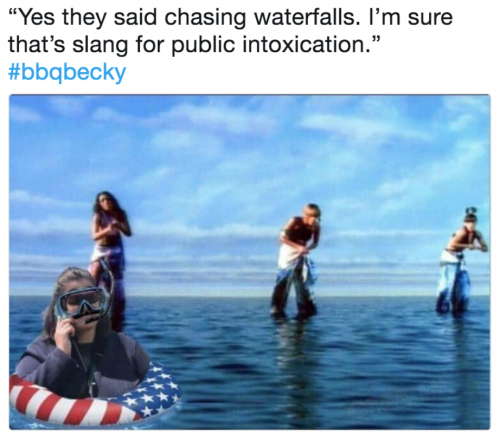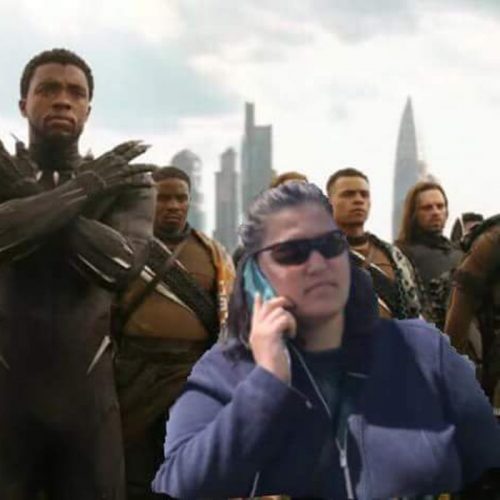Over the past few months, we have seen several high profile news stories about white Americans threatening to call, or calling, police on people of color for a range of everyday activities like looking out of place on a college tour, speaking Spanish with cashiers at a local restaurant, meeting at Starbucks, and removing luggage from your AirBnB. Perhaps most notably, one viral YouTube video showing a white woman calling the police on a group of Black people supposedly violating park rules by using charcoal on their grill spawned the meme “BBQ Becky.”


While the meme pokes fun at white fears of people of color, these incidents reflect bigger trends about who we think belongs in social settings and public spaces. Often, these perceptions — about who should and shouldn’t be at particular places — are rooted in race and racial difference.
There’s research on that! Beliefs about belonging particularly affect how Black people are treated in America. Sociologist Elijah Anderson has written extensively about how certain social settings are cast as a “white space” or a “black space.” Often, these labels extend to public settings, including businesses, shopping malls, and parks. Labels like these are important because they can lead to differences in how some people are treated, like the exclusion of the two Black men from Starbucks.
- Anderson, Elijah. 2011. The Cosmopolitan Canopy: Race and Civility in Everyday Life. W.W. Norton & Company.
- Elijah Anderson. 2015. “The White Space.” Sociology of Race & Ethnicity 1(1): 10-21.
When addressing race and social space, social scientists often focus on residential segregation, where certain neighborhoods are predominantly comprised of members of one racial group. While these dynamics have been studied since the mid 20th century, research shows that race is still an important factor in determining where people live and who their neighbors are — an effect compounded by the 2008 financial crisis and its impacts on housing.
- Jacob S Rugh, Len Albright, and Douglas S. Massey. 2015. “Race, Space, and Cumulative Disadvantage: A Case Study of the Subprime Lending Collapse.” Social Problems 62(2): 186-208.
- Matthew Hall, Kyle Crowder, and Amy Spring. 2015. “Neighborhood Foreclosures, Racial/Ethnic Transitions, and Residential Segregation.” American Sociological Review 80(3): 526-529.
- Ray Sin and Maria Krysan. 2015. “What Is Racial Residential Integration? A Research Synthesis, 1950–2013.” Sociology of Race and Ethnicity (1)4: 467-474
The memes are funny, but they can also launch important conversations about core sociological trends in who gets to be in certain social spaces.
Amber Joy is a PhD student in sociology at the University of Minnesota. Her current research interests include punishment, sexual violence and the intersections of race, gender, age, and sexuality. Her work examines how state institutions construct youth victimization.
Neeraj Rajasekar is a Ph.D. student in sociology at the University of Minnesota studying race and media.

Comments 4
Lillian Turcotte — May 20, 2021
These memes are very famous these days on Twitter and people are sharing them to have fun with their friends. The editing skills of this person are not so good but still, he managed to get famous around the globe. Well, I also visit Casinosfellow source to read different useful articles about the casino before playing it.
Howard — November 27, 2021
I'm a teacher and https://writemyessay.nyc contributor. Our high school asks all teachers to recommend a good book with a short synopsis for students to read (not necessarily related to the subjects they teach). This provides students with a wide range of options to choose from. Students must choose one book and sign up to be part of that reading group (which has limited spaces available). This incentivizes students to choose one book that looks interesting while exposing them to a wide variety of others. They might choose a book based on the subject matter or even because they think their favorite teacher has good taste, a sense of humor, or is deeply insightful. Time is set aside early the following year to get together and discuss the books as a group. They might moan and complain, but if they choose something that at least sounds interesting to them, they might be more likely to actually enjoy it. The only way to get kids interested in reading is to get them reading.
kashif kashif kashif — July 24, 2025
Its gathered on your site even though reducing popularity merely quite a few tid tiny bit submits. Enjoyable technique for impending, I'll be book-marking before starting purchase products and solutions final result spgs up right up. 비아그라 구매
kasif sofeyn kasan — July 25, 2025
There are certain posts on the market near this, I do think taking there reference could experience made this spot or article really informative. I’m not really expression this post is unhealthy. Simply I’ve got to pronounce the fact that info provided here was unique, merely so it will be more close to complete, supporting compared to other former information will receive been actually good. The points you will enjoy touched listed here are really important, thus I am going to spot some of the information here to build this actually great for entirely the newbie’s here. Thank you for this info. Actually helpful! nowgoal